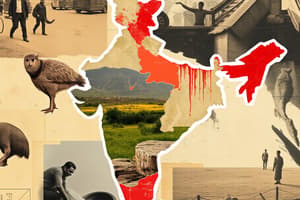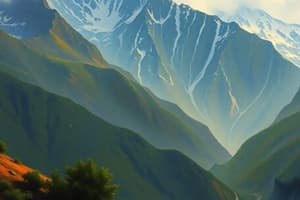Podcast
Questions and Answers
Which river is known as a major tributary of the Ganges and is significant for irrigation?
Which river is known as a major tributary of the Ganges and is significant for irrigation?
- Yamuna (correct)
- Indus
- Godavari
- Brahmaputra
What climate zone is characterized by heavy monsoon rains and found in the western coast and northeastern regions?
What climate zone is characterized by heavy monsoon rains and found in the western coast and northeastern regions?
- Tropical Wet (correct)
- Tropical Dry
- Subtropical Humid
- Desert Climate
Which major river flows through Northeast India and is important for biodiversity?
Which major river flows through Northeast India and is important for biodiversity?
- Yamuna
- Brahmaputra (correct)
- Krishna
- Ganges
What is the primary climate characteristic of the Thar Desert?
What is the primary climate characteristic of the Thar Desert?
Which two rivers are known for their significance in irrigation and hydroelectric power in South India?
Which two rivers are known for their significance in irrigation and hydroelectric power in South India?
Which mountain range is known to be the youngest and home to some of the world's highest peaks?
Which mountain range is known to be the youngest and home to some of the world's highest peaks?
What major river systems contribute to the formation of the Indo-Gangetic Plain?
What major river systems contribute to the formation of the Indo-Gangetic Plain?
Which region of India is characterized by a distinct Dravidian culture and is famous for its classical dance?
Which region of India is characterized by a distinct Dravidian culture and is famous for its classical dance?
What is a significant characteristic of the Thar Desert?
What is a significant characteristic of the Thar Desert?
Which city is recognized as India's financial capital and cultural hub?
Which city is recognized as India's financial capital and cultural hub?
What challenge does rapid urbanization in India primarily lead to?
What challenge does rapid urbanization in India primarily lead to?
Which part of India is known for its unique customs and has a rich biodiversity?
Which part of India is known for its unique customs and has a rich biodiversity?
Which geographical feature is crucial for agriculture due to its rich mineral composition?
Which geographical feature is crucial for agriculture due to its rich mineral composition?
Flashcards
Himalayas
Himalayas
Youngest mountain range in the world, home to the highest peaks, acting as a natural barrier.
Indo-Gangetic Plain
Indo-Gangetic Plain
Fertile land formed by river deposits (Ganges, Yamuna, Indus), crucial for agriculture and densely populated.
Thar Desert
Thar Desert
Arid region in northwest India with sand dunes, limited vegetation and water.
Western/Eastern Ghats
Western/Eastern Ghats
Signup and view all the flashcards
Deccan Plateau
Deccan Plateau
Signup and view all the flashcards
North India
North India
Signup and view all the flashcards
South India
South India
Signup and view all the flashcards
Ganges River
Ganges River
Signup and view all the flashcards
Urbanization Trends
Urbanization Trends
Signup and view all the flashcards
Rural-Urban Migration
Rural-Urban Migration
Signup and view all the flashcards
Mumbai
Mumbai
Signup and view all the flashcards
Delhi
Delhi
Signup and view all the flashcards
Tropical Wet Climate
Tropical Wet Climate
Signup and view all the flashcards
Study Notes
Indian Geography Study Notes
Physical Features
-
Himalayas:
- Youngest mountain range; home to some of the world's highest peaks (e.g., Mount Everest).
- Acts as a natural barrier, influencing climate and culture.
-
Indo-Gangetic Plain:
- Fertile region formed by the alluvial deposits of the Ganges, Yamuna, and Indus rivers.
- Essential for agriculture; densely populated.
-
Thar Desert:
- Located in northwest India; characterized by arid conditions and sand dunes.
- Limited vegetation and water resources.
-
Western and Eastern Ghats:
- Mountain ranges running parallel to the west and east coasts.
- Rich biodiversity; significant for agriculture (tea, coffee plantations).
-
Deccan Plateau:
- Elevated flat region in southern India; consists of basalt rock.
- Varied climate and rich in minerals.
Cultural Regions
-
North India:
- Influenced by Indo-Aryan culture; known for diverse languages, religions (Hinduism, Sikhism), and festivals.
-
South India:
- Distinct Dravidian culture; famous for classical dance, cuisine, and temples.
-
East India:
- Known for unique traditions, art forms, and languages (Bengali, Odia).
-
West India:
- A blend of various cultures; known for Bollywood, crafts, and cuisine (Gujarati, Marathi).
-
Northeast India:
- Diverse ethnic groups and languages; known for unique customs, handicrafts, and rich biodiversity.
Urban Geography
-
Major Cities:
- Mumbai: Financial capital, cultural hub.
- Delhi: Political capital, historical sites.
- Kolkata: Hub of art and literature.
- Bangalore: Tech capital, known for IT industries.
-
Urbanization Trends:
- Rapid urban growth leading to challenges like housing, transportation, and pollution.
- Development of smart cities initiative to improve urban infrastructure.
-
Rural-Urban Migration:
- Movement of people from rural areas to cities for better job opportunities and living conditions.
Major Rivers
-
Ganges:
- Sacred river; crucial for agriculture and cultural practices.
-
Yamuna:
- Major tributary of the Ganges; significant for irrigation and water supply.
-
Brahmaputra:
- Flows through Northeast India; important for biodiversity and agriculture.
-
Indus:
- Originates in Tibet; flows through northern India into Pakistan, significant for historical civilizations.
-
Godavari and Krishna:
- Major rivers in South India; important for irrigation and hydroelectric power.
Climate Zones
-
Tropical Wet:
- Characterized by heavy monsoon rains; found in the western coast and northeastern regions.
-
Tropical Dry:
- Hot and dry conditions; prevalent in interior regions and parts of the Deccan Plateau.
-
Subtropical Humid:
- Found in Northern India; seasonal variations with hot summers and cool winters.
-
Mountain Climate:
- Varies with altitude; cooler temperatures in the Himalayas.
-
Desert Climate:
- Arid conditions in the Thar Desert; very little rainfall and extreme temperatures.
Physical Features
-
Himalayas:
- The youngest mountain range, hosting the highest peaks, including Mount Everest.
- Serves as a natural barrier that significantly shapes regional climate and cultural dynamics.
-
Indo-Gangetic Plain:
- Highly fertile area formed by alluvial deposits from the Ganges, Yamuna, and Indus rivers.
- Critical for agriculture, leading to a high population density.
-
Thar Desert:
- Located in northwest India, defined by its arid climate and extensive sand dunes.
- Characterized by scarce vegetation and limited water resources.
-
Western and Eastern Ghats:
- Mountain ranges running parallel along India's west and east coasts.
- Known for rich biodiversity, with significant agricultural contributions, particularly in tea and coffee cultivation.
-
Deccan Plateau:
- An elevated flat region located in southern India, primarily composed of basalt rock.
- Features a varied climate and is rich in mineral resources, including coal and iron ore.
Cultural Regions
-
North India:
- Predominantly influenced by Indo-Aryan culture, marked by a multitude of languages, religions (notably Hinduism and Sikhism), and vibrant festivals.
-
South India:
- Recognized for its unique Dravidian culture, noted for classical dance forms, flavorful cuisine, and majestic temples.
-
East India:
- Renowned for distinctive traditions, art forms, and languages such as Bengali and Odia, contributing to a rich cultural tapestry.
-
West India:
- A melting pot of various cultures, celebrated for Bollywood cinema, diverse crafts, and culinary delights from states like Gujarat and Maharashtra.
-
Northeast India:
- Home to a mosaic of ethnic groups and languages, known for its unique customs, exquisite handicrafts, and vibrant biodiversity.
Urban Geography
-
Major Cities:
- Mumbai serves as the financial and cultural capital of India.
- Delhi is the political capital and hosts numerous historical landmarks.
- Kolkata is recognized for its artistic heritage and literary contributions.
- Bangalore has earned the title of tech capital, distinguished for its burgeoning IT industry.
-
Urbanization Trends:
- Rapid urban growth that is presenting challenges in housing, transportation, and environmental pollution.
- The smart cities initiative aims to enhance urban infrastructure and living conditions.
-
Rural-Urban Migration:
- A significant trend where individuals migrate from rural areas to urban centers in pursuit of improved job prospects and living standards.
Major Rivers
-
Ganges:
- Regarded as a sacred river, it plays a pivotal role in agriculture and cultural rituals across India.
-
Yamuna:
- A significant tributary of the Ganges, essential for irrigation and providing water supply to millions.
-
Brahmaputra:
- Flows through Northeast India, known for its vital contribution to the region's agriculture and rich biodiversity.
-
Indus:
- Originates in Tibet and traverses northern India into Pakistan, historically crucial for the development of ancient civilizations.
-
Godavari and Krishna:
- Major rivers in South India that are instrumental for irrigation purposes and hydroelectric power generation.
Climate Zones
-
Tropical Wet:
- Characterized by heavy monsoon rainfall, primarily found along the western coast and in northeastern regions.
-
Tropical Dry:
- Exhibits hot and arid conditions, prevalent in the interior regions and parts of the Deccan Plateau.
-
Subtropical Humid:
- Found in Northern India, showcasing seasonal climate variations with hot summers and relatively cool winters.
-
Mountain Climate:
- Varies based on altitude, with cooler temperatures dominating the Himalayas.
-
Desert Climate:
- Experiences arid conditions in the Thar Desert, marked by minimal rainfall and extreme temperature fluctuations.
Studying That Suits You
Use AI to generate personalized quizzes and flashcards to suit your learning preferences.




